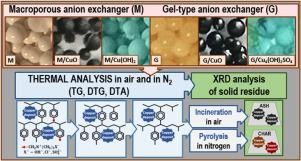当前位置:
X-MOL 学术
›
Thermochim. Acta
›
论文详情
Our official English website, www.x-mol.net, welcomes your
feedback! (Note: you will need to create a separate account there.)
Effect of the kind of cupric compound deposit on thermal decomposition of anion exchangers
Thermochimica Acta ( IF 3.1 ) Pub Date : 2021-01-01 , DOI: 10.1016/j.tca.2020.178812 Elżbieta Kociołek-Balawejder , Ewa Stanisławska , Igor Mucha
Thermochimica Acta ( IF 3.1 ) Pub Date : 2021-01-01 , DOI: 10.1016/j.tca.2020.178812 Elżbieta Kociołek-Balawejder , Ewa Stanisławska , Igor Mucha

|
Abstract The effect of the inorganic deposit on the thermal decomposition of hybrid ion exchangers (HIXs) has not been comprehensively studied before. Therefore, as part of this research anion exchangers containing cupric compound in their matrix (CuO, Cu(OH)2 and Cu4(OH)6SO4) were subjected to thermal analysis. Strongly basic commercial anion exchangers, i.e. a macroreticular anion exchanger (M) and a gel-like anion exchanger (G), were used as the host materials. M, M/CuO, M/Cu(OH)2 and G, G/CuO, G/Cu4(OH)6SO4 were subjected to thermal analysis under respectively air and N2. The samples of the HIXs contained 57.8-84.5 mg Cu/g. The results of twelve experiments are discussed on the basis of the TG/DTG curves and XRD patterns for the solid residues. The effects of: (a) the process conditions, (b) the type of deposit and (c) the structure of the anion exchanger on the course of the thermal transformations, the process end temperature, the amount of carbonizate in the post-pyrolysis residue and the composition of the inorganic phase (CuO after combustion, Cu0 or Cu2S after pyrolysis) were determined. It was demonstrated that during the thermal decomposition of the HIXs under N2 the reduction of Cu(II) was taking place, and owing to this hydrogen-consuming conversion more carbonizate formed than in the pyrolysis of the pure resins, as under hydrogen deficit the hydrocarbon radicals condensed into large non-volatile particles.
中文翻译:

铜化合物沉积物的种类对阴离子交换剂热分解的影响
摘要 无机沉积物对混合离子交换剂(HIXs)热分解的影响以前没有得到全面的研究。因此,作为本研究的一部分,对基质中含有铜化合物的阴离子交换剂(CuO、Cu(OH)2 和 Cu4(OH)6SO4)进行了热分析。强碱性商业阴离子交换剂,即大网状阴离子交换剂(M)和凝胶状阴离子交换剂(G),被用作主体材料。M、M/CuO、M/Cu(OH)2 和 G、G/CuO、G/Cu4(OH)6SO4 分别在空气和 N2 下进行热分析。HIX 的样品含有 57.8-84.5 mg Cu/g。在固体残留物的 TG/DTG 曲线和 XRD 谱的基础上讨论了十二个实验的结果。影响: (a) 工艺条件,(b) 沉积物的类型和 (c) 热转变过程中阴离子交换剂的结构、过程结束温度、热解后残留物中碳化物的量和无机相的组成(CuO燃烧、热解后的 Cu0 或 Cu2S)进行测定。结果表明,在 N2 下 HIX 的热分解过程中,发生了 Cu(II) 的还原,并且由于这种消耗氢的转化,形成的碳化物比纯树脂热解中形成的碳化物更多,因为在氢不足的情况下,碳氢化合物自由基凝结成大的非挥发性颗粒。热解后的 Cu0 或 Cu2S)进行测定。结果表明,在 N2 下 HIX 的热分解过程中,发生了 Cu(II) 的还原,并且由于这种消耗氢的转化,形成的碳化物比纯树脂热解中形成的碳化物更多,因为在氢不足的情况下,碳氢化合物自由基凝结成大的非挥发性颗粒。热解后的 Cu0 或 Cu2S)进行测定。结果表明,在 N2 下 HIX 的热分解过程中,发生了 Cu(II) 的还原,并且由于这种消耗氢的转化,形成的碳化物比纯树脂热解中形成的碳化物更多,因为在氢不足的情况下,碳氢化合物自由基凝结成大的非挥发性颗粒。
更新日期:2021-01-01
中文翻译:

铜化合物沉积物的种类对阴离子交换剂热分解的影响
摘要 无机沉积物对混合离子交换剂(HIXs)热分解的影响以前没有得到全面的研究。因此,作为本研究的一部分,对基质中含有铜化合物的阴离子交换剂(CuO、Cu(OH)2 和 Cu4(OH)6SO4)进行了热分析。强碱性商业阴离子交换剂,即大网状阴离子交换剂(M)和凝胶状阴离子交换剂(G),被用作主体材料。M、M/CuO、M/Cu(OH)2 和 G、G/CuO、G/Cu4(OH)6SO4 分别在空气和 N2 下进行热分析。HIX 的样品含有 57.8-84.5 mg Cu/g。在固体残留物的 TG/DTG 曲线和 XRD 谱的基础上讨论了十二个实验的结果。影响: (a) 工艺条件,(b) 沉积物的类型和 (c) 热转变过程中阴离子交换剂的结构、过程结束温度、热解后残留物中碳化物的量和无机相的组成(CuO燃烧、热解后的 Cu0 或 Cu2S)进行测定。结果表明,在 N2 下 HIX 的热分解过程中,发生了 Cu(II) 的还原,并且由于这种消耗氢的转化,形成的碳化物比纯树脂热解中形成的碳化物更多,因为在氢不足的情况下,碳氢化合物自由基凝结成大的非挥发性颗粒。热解后的 Cu0 或 Cu2S)进行测定。结果表明,在 N2 下 HIX 的热分解过程中,发生了 Cu(II) 的还原,并且由于这种消耗氢的转化,形成的碳化物比纯树脂热解中形成的碳化物更多,因为在氢不足的情况下,碳氢化合物自由基凝结成大的非挥发性颗粒。热解后的 Cu0 或 Cu2S)进行测定。结果表明,在 N2 下 HIX 的热分解过程中,发生了 Cu(II) 的还原,并且由于这种消耗氢的转化,形成的碳化物比纯树脂热解中形成的碳化物更多,因为在氢不足的情况下,碳氢化合物自由基凝结成大的非挥发性颗粒。











































 京公网安备 11010802027423号
京公网安备 11010802027423号